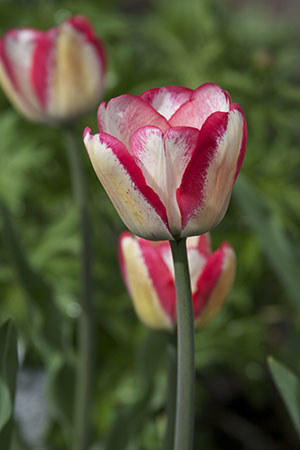Lawns
- Mow your grass to 3 inches or higher for the healthiest lawn. Longer grass means longer roots below ground and that gives you a healthy thick turf that will crowd out weeds.
- Mow frequently, keep your mower blade sharp and leave the clippings on the lawn for added nutrients.
- If you have a widespread problem with weeds use a broad-leaf weed killer as the label recommends.
- If you only have a few weeds, just spot treat instead of treating your entire lawn.
Flowers
- Deadhead spring bulbs and plant summer-flowering bulbs in May.
Set peony supports in place before the growth makes it difficult. - Divide and transplant summer flowering perennials except peonies, iris and oriental poppies.
- Plant tender annuals mid-May after threat of frost is past.
- Feed roses every two to three weeks and if you had black spot on your roses last season, treat frequently with a fungicide – following the label.
- Pinch back hardy mums and fertilize.
- Keep an eye on your containers – they can dry out quickly.
Woody plants
- Prune spring-flowering shrubs right after they finish blooming.
- Prune trees such as maple, sycamore, birch and crabapple from mid-June to mid-July to avoid bleeding and rampant growth of suckers.
- Hedges can be rejuvenated and evergreens that were winter pruned can be cleaned up in June.
- If you have ash trees (not mountain ash), formulate a plan on how you will deal with Emerald Ash Borer. For more information go to the New York Invasive Species Info website or call your local Extension office.
Vegetables and Fruit
- After our cold and late spring, keep an eye on May’s weather forecast and if frost threatens, cover any tender plants you may have put out early.
- Prune to remove dead or diseased branches of fruit trees.
- Pick your strawberries when they are fully red for maximum sweetness and flavor.
- You may need to cover your plants with bird netting to keep them for yourself!
- Sow beans, beets and carrots every two weeks until the end of June to keep your harvest season going.
- Plant out your tomato, pepper and eggplant seedlings after danger of frost is past.
- Mulch around your veggies to conserve moisture and keep weeds down.
- Check out Cornell Cooperative Extension for tips on all your crops and to get a list of recommended varieties for New York State.
Houseplants
- Most of them LOVE to spend the summer outdoors! Find a protected place in light shade and out of the way of wind and move them when nights are consistently in the 50’s.
- Don’t forget that outdoor summering houseplants will need more water if the weather turns hot and dry.
- Now that they are actively growing, fertilize with a general-purpose houseplant fertilizer or add a slow-release one to each pot before you set it out. Follow the label directions.
—Karen S. Klingenberger, Consumer Horticulture Educator at Cornell Cooperative Extension of Monroe County.
Views: 1







